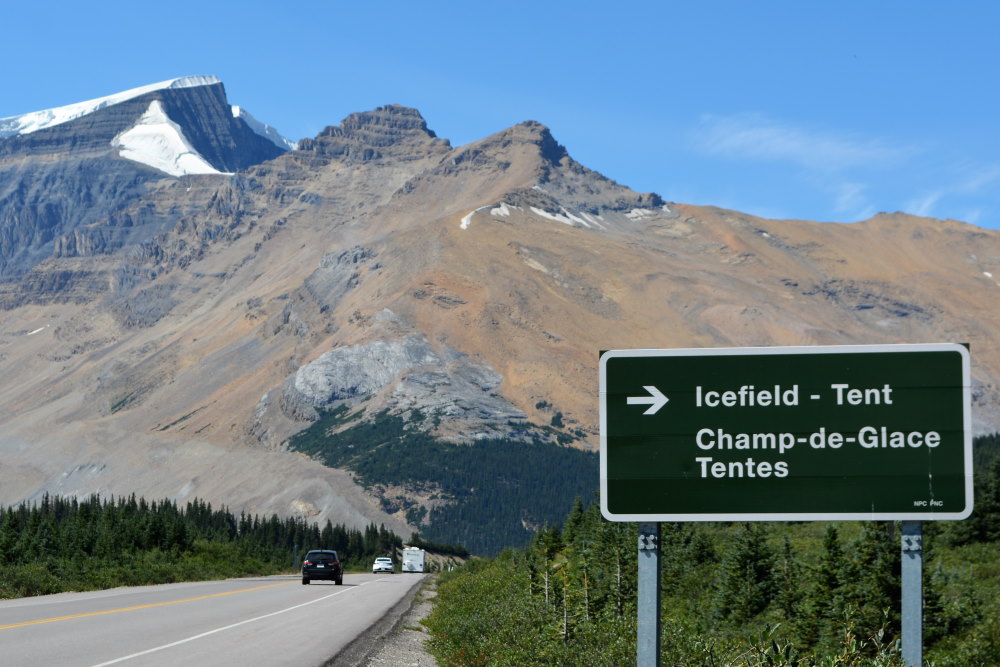The summer of 2021 was poised to be a big one for Jasper National Park. The grand re-opening of Whistlers Campground after a major, multi-year refurbishment was coming and I was itching to see the results. In fact, this had been on my mental camping To Do list since the renovation was announced. I could hardly wait, checking the reservation website seemingly daily for the opportunity to book a couple nights in what promised to be an amazing “new” campground. Then … reality tossed a curveball.
Almost simultaneous with reservations opening on the Parks Canada website, news trickled to my ears that a great number of trees had been removed from the campground. Similar cutting had razed much of Wapiti as well. Not surprising since mountain pine beetle had wrought havoc on Jasper and the whole park was/is a forest fire waiting to happen. Still, the visual evidence was a shock.
This news sapped my enthusiasm for an immediate visit to Whistlers. Dead of summer with little to no tree cover isn’t my idea of fun camping. Certainly not when a six-hour drive is required to get there. So, despite the two plus years of waiting and building excitement, I passed on camping at Whistlers.
I did not, however, give up on camping in Jasper. While the above non-story played out, things were shaping up for a special outing with my son. My daughter was registered for a week-long, overnight horse camp near Rocky Mountain House and I thought it would be fun to spend the week tent camping with my boy rather than drive back and forth twice each to deliver and pick up my girl.
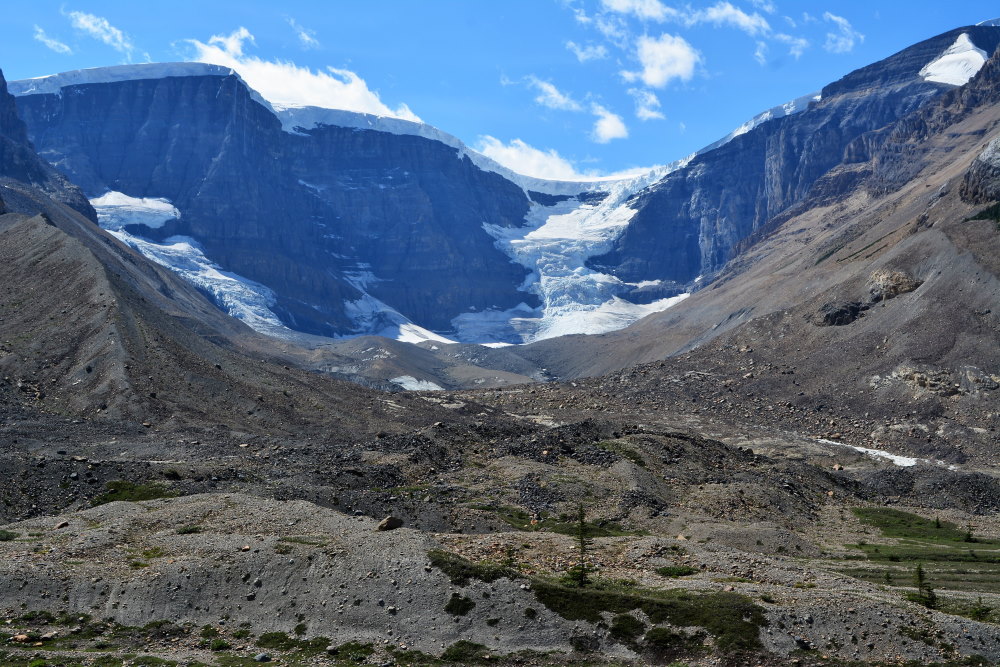
After getting the green light from my wife who would be left all alone at home (never sure if that’s a slight or a delight), I made plans for four nights of camping. We would go against my nature and not reserve any sites, instead rolling the dice with FCFS campsites at two potentially spectacular campgrounds: Crescent Falls Provincial Recreation Area and Icefields Tent in Jasper. Both were successful. This is the story of the latter.
Anything Icefields is sure to be extremely popular, but upon our arrival Wednesday early afternoon we had a choice of several sites. More than half of the campground, I would wager, though the very best sites from a view perspective were already filled. I suspect the lingering covid hangover limiting international travel coupled with the ever-present threat of fire smoke kept the availability odds in our favour.
I’d never camped in a tent only campground before. Can’t say I even know of another one, though I don’t exactly seek them out. I assume Icefields Tent is exclusive to the national parks system and the global status of Banff and Jasper hold. It just feels like the type of attraction that sees lots of out-of-province and out-of-country travelers, particularly of the younger set.
I wasn’t wrong in that assumption as we learned more than once during our stay. The first night, we had settled into our chairs enjoying the campfire as we awaited the stars. By 10:30 it was getting dark enough to start watching the Perseid meteor shower. This was also the time a carload of young folks pulled in to set up camp in the site next to ours.
They were happy and boisterous, as expected. Tents were erected in the brightness of headlights and then a meal was had followed by hours of conversation. Were we not already committed to late night stargazing, I imagine I’d have been much more agitated by the disruption. They were also gone early the next morning.
None of this was surprising. I fully anticipated such fly-by-night campers in a campground such as Icefields Tent. It’s summer and the young adventurers are out exploring this amazing country. I was like them once, so I’m not begrudging them.
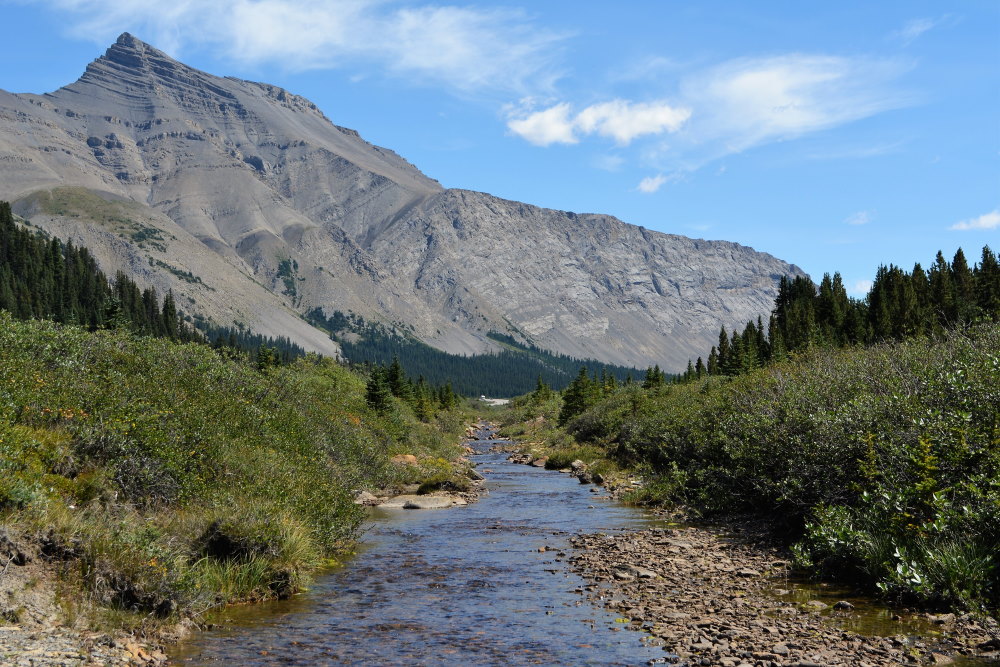
On the second night a similar scenario played out, though earlier in the evening. This time two carloads of young men arrived and laid claim to a site across the road from us. This group was louder and far less respectful of the park. They gathered wood from the surrounding forest, “chopped” it by angling it up to their SUV bumper and jumping on it, a definite no-no. I was disappointed with this activity but kept to myself focusing instead on the stars appearing overhead.
I guess my point with all of this is that Icefields Tent is not your average weekend family campground. With no RVs, inside a major national park, and next to a prime tourist attraction, you are bound to experience a different vibe and different clientele. I came fully expecting this and was rewarded for the prescience.
To be honest, I was prepared for far worse. I imagine under non-pandemic circumstances and with unrestricted international travel happening, Icefields Tent campground is a very busy, entertaining place with lots of young adventurers out enjoying their youth. Hell, I wish I could be one of them again.
So, while I wasn’t exactly enamoured with the tempered version we endured, I still enjoyed the experience and left with no additional grey hairs or ulcers than when I arrived. Icefields Tent is what it is. Some of you are likely seeking exactly this kind of environment. And after a long day of hiking or sight-seeing, a little merry-making won’t kill you or your curmudgeonly campground neighbour … i.e. me.
Icefields Tent Campground
With that out of the way, let’s talk about Icefields Tent itself. I was curious to know what makes a tent-only campground, well, that. I rightly assumed it would be size, but I was still surprised by just how much it was true.
I’ve seen walk-in tenting areas in several provincial parks. Just recently, we’d been to Chinook Provincial Recreation Area which has a tent-only mini-loop. Neither quite prepared me for Icefields Tent which is a vehicle-friendly campground that only allows tents.
There is a total of 31 campsites at Icefields Tent, although the website says there are 33 for some reason. 10 are walk-in and the remaining 21 are regular campsites sized for tents. And not just any tent. Many of the vehicle accessible sites are fairly small, with tiered platforms for vehicle, tent, and picnic/firepit.
Ours was one such example. The driveway was long enough for most vehicles though its orientation was a pain for reversing into the site. The angle of many sites around the one-way loop enables only front-in parking barring some inventive massaging of traffic rules (which I did!). Backing in is obviously more helpful for loading and unloading. We chose our site for the view but admit the driveway orientation sucked.
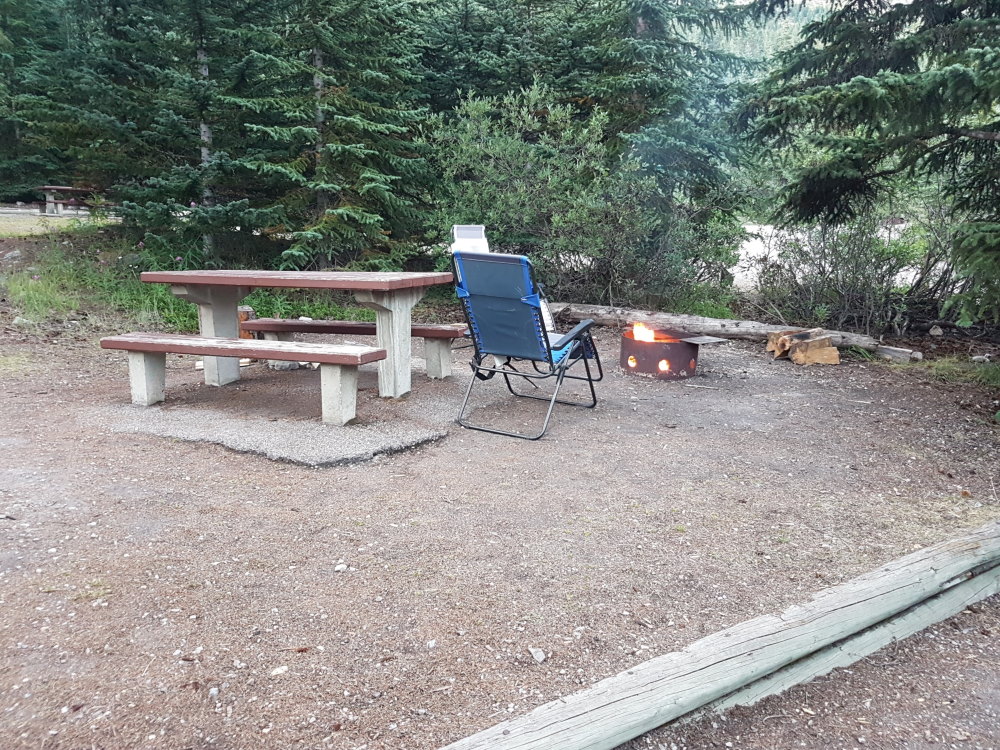
Anyway, the vehicle portions of these campsites are limited by a robust wooden barricade. Beyond the barricade is the picnic table and fireplace area. The tables are immovable concrete with wood tops and seats positioned on  weathered asphalt. The tabletops are worn and strewn with graffiti and carvings but otherwise do their job. My only legitimate complaint is the inability to move the picnic table which was too close to the firepit imho.
weathered asphalt. The tabletops are worn and strewn with graffiti and carvings but otherwise do their job. My only legitimate complaint is the inability to move the picnic table which was too close to the firepit imho.
Local wildlife has discovered the benefits of living near campers. We had a friendly chipmunk (it’s not really a chipmunk but looks very much like one) visit us for every meal, desperate to abscond with our droppings.
Ninety degrees to the right is the tent platform, a foot or so down from the firepit tier. Like the others, this platform is mostly dirt and small gravel. Tent peg insertion is doable with some effort. Could be better, could be worse.
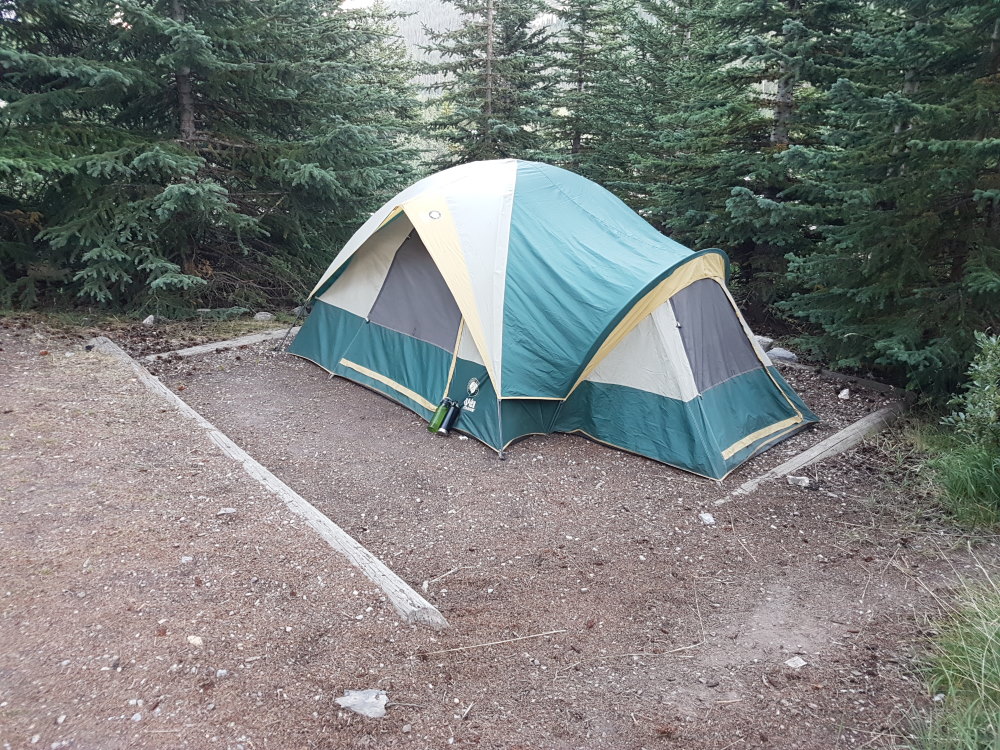
The plot accommodated our “5 man” tent perfectly, but you wouldn’t get anything much bigger on it. This surprised me a bit. Upon reflection, I don’t imagine many tourists come with massive family tents in tow, so perhaps the sizing of this platform is purposeful. I just expected more room similar to the sprawling tent campsites often found in the aforementioned provincial parks.
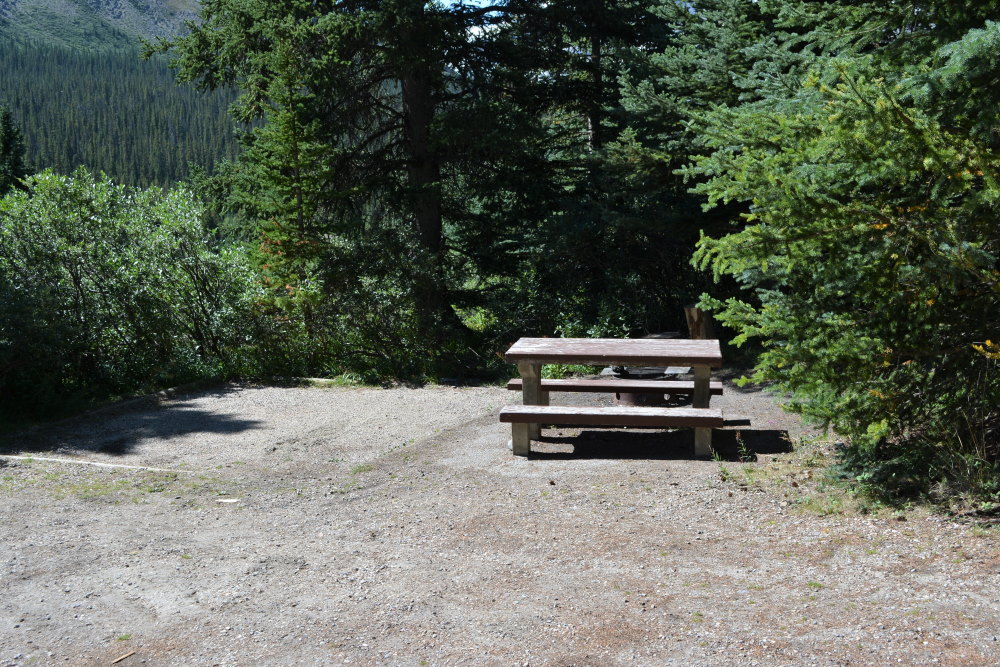
Not all campsites at Icefield Tent were identical to ours. Some were simple, open plots with no trees and little room for anything beyond a small vehicle and a single tent while others were somewhat larger and without the tiering. Availability notwithstanding, you should be able to find something that suits your gear.
I should note that in the northwest corner of the triangular loop, there are a handful of gorgeous campsites with exquisite views of the southern portion of the Columbia Icefields. These sites were all occupied when we arrived and I’m sure they’re gone within minutes of being vacated. And for good reason.

The campground is located on the north side of Icefields Parkway at the base of the mountains. It is fully forested which, while great for protection from the sun, obstructs views of the amazing mountains all around it. Trying to balance convenience to facilities with shelter with privacy with views is quite the ordeal at Icefields Tent and we drove the loop at least three times before settling on a site.
Now, you can simply walk ten feet and see beautiful views so its not a zero-sum game by any means. But there is significant appeal to being able to recline in your zero-gravity lawnchair and stare at Rocky Mountains and glaciers while the fire crackles at your feet. We achieved this, if just, in site 31 but had to tolerate garbage bin proximity as payment. There’s always a cost.
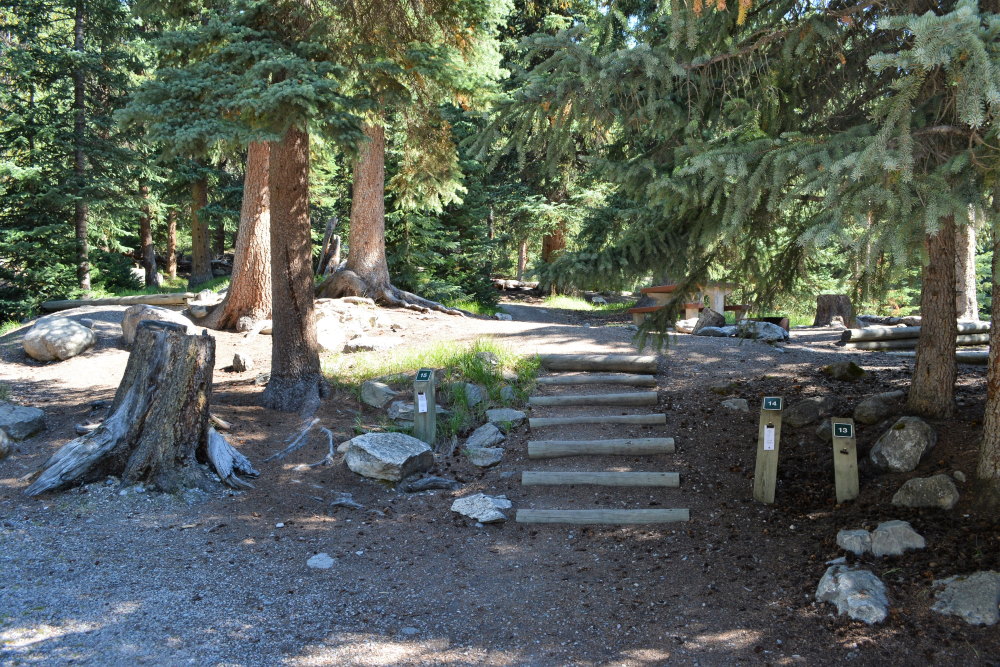
If you bank on getting your fill of incredible vistas during the day, then there are several campsites at Icefield Tent that offer intriguing surroundings minus a view. Sites 13 through 17 are walk-ins and part of the main campground loop. They have a sort of group parking area rather than individual driveways, and the sites are then found up some steps into the woods.

Clustered together like this, they’d make great spots for groups of friends (or exceptionally social travelers, I suppose). The trees combined with the tiered nature of these sites gives them their own unique appeal that should not be discounted. And with nothing but nature behind them, you won’t linger on the missing mountain view.
To wit, in behind the 13/14/15 grouping is a creek tumbling down from the mountains around Nigel Peak. If you love the sounds of water near your campsite, these sites are right up your alley with 14 the closest. It’s like the world’s biggest water feature in your backyard.

This creek, the name of which I do not know, nor can I find, is an enigma of sorts. We first encountered it as we explored the exclusive walk-in sites (more on those in a bit). Two pedestrian bridges cross a rocky mountain streambed but there is no water beneath them. You can hear water. You can see it upstream. But beneath and notably downstream of the bridges, the water is gone leaving nothing but a barren, engineered, boulder-lined floodway.
This was mighty strange. Later in our stay, we explored the creek upwards into the hills. It’s a lovely stream you can follow for hundreds of meters. You can likely follow it right up to the mountain from which it originates, but we weren’t that ambitious.

As you gain elevation scrambling up this creek, you’ll encounter open spots with fantastic views of the spectacular surroundings. There is an unofficial dirt trail to the east side of the creek starting in the exclusive walk-in tenting area. This helps navigating the early portion of the creek, but you can also just scramble up the creak bed itself hopping from rock to outcrop and back.
 This creek is also the water source for Icefields Tent campground. This was another surprise and something I’ve never seen before. At the back of the campground, between the two sets of walk-in sites (12 through 17) is a large plastic storage bin enclosed in a wooden fence. On the front is a single faucet. This is the potable water.
This creek is also the water source for Icefields Tent campground. This was another surprise and something I’ve never seen before. At the back of the campground, between the two sets of walk-in sites (12 through 17) is a large plastic storage bin enclosed in a wooden fence. On the front is a single faucet. This is the potable water.
Behind this structure is a black hose draped on the ground heading off towards the creek. Follow it behind the campsites and you’ll discover its end with a filter contraption submerged in the mountain creek.
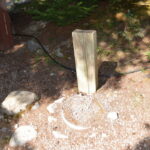
I have no idea if they treat the water in the big, plastic tank. One would think they must. We had brought our own water for drinking and cooking so only used this water a couple times to wash hands. I did not taste it to confirm any noticeable treatment chemicals. And there were no warning signs posted suggesting users boil the water.
There’s also evidence, that a more conventional water source once existed at Icefields Tent campground. In fact, right next to the fenced in tank is a lone post with the tell-tale mesh grate in the ground below for capturing stray water from the now missing faucet. Where that water was once sourced from is a mystery. Put it all together and this is the oddest potable water setup I’ve yet seen but, at least it’s there should you need it.
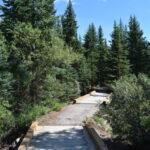
Back to the walk-in tent sites for minute. Sites 1 through 5 are also walk-ins and somewhat more traditionally at that. A parking area near the campground entrance is reserved for these sites. This is admittedly not a convenient location to park and requires some extra walking.
Located quite separate from the remainder of the campground, a single trail leads you to the five sites. They are modestly sized with decent privacy between them. From a seclusion perspective, they’re quite nice though you’ll certainly encounter users of the other four walk-in sites.

We scoped them out but determined we’d prefer the convenience of a vehicle access site. I can appreciate that some campers would find these five sites to be the best of the best though again I must caution that the forest blocks much, if not all, of the mountain view. There is that trail up the hillside beside the creek.

Back in the main campground loop, you will find a handful of interior sites that share the inner-loop with two picnic shelters. These semi-enclosed structures are quaint as hell. Both are old, each with a distinctive, rustic look. For reasons unexplained, I only managed an exterior picture of the one.
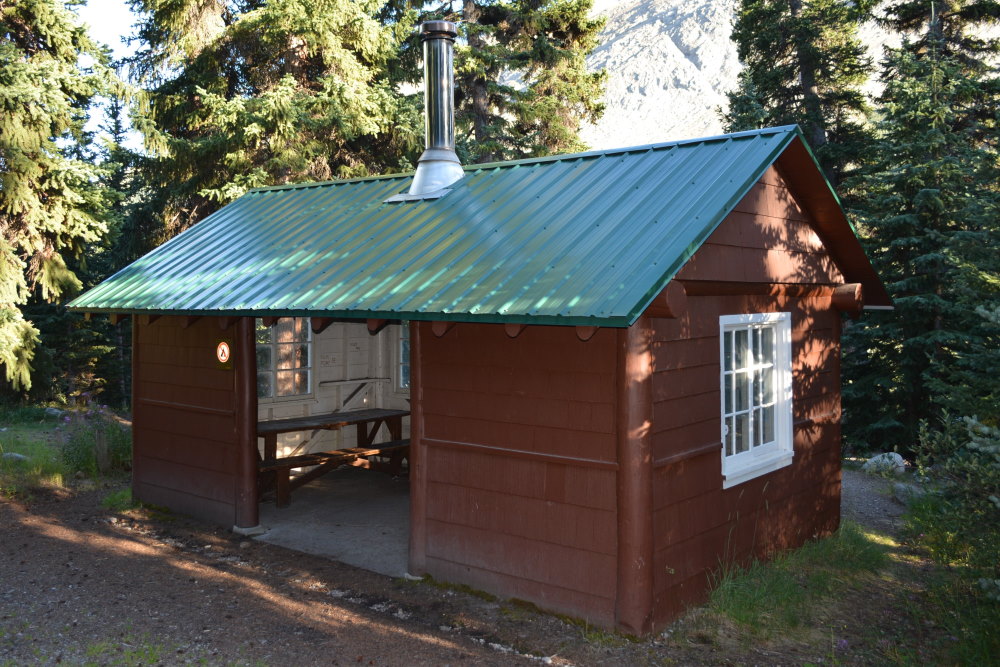
Inside both you’ll find the anticipated table and wood stove. One of them also had a stand of food storage lockers. The other also had food lockers but on the outside a few paces from the structure.
 Nobody made use of these shelters during our two-night stay. Even campers in sites right next to them kept to their own grounds rather than making use of the shelters. I’d hope they get some use during the summer beyond hiding from storms.
Nobody made use of these shelters during our two-night stay. Even campers in sites right next to them kept to their own grounds rather than making use of the shelters. I’d hope they get some use during the summer beyond hiding from storms.
 Firewood is currently free in Jasper. I’m unsure if this a blanket policy or a reflection of all the deadwood they’ve cut down in various campgrounds. I suspect the latter. Regardless, in 2021 the firewood was free (check before you come).
Firewood is currently free in Jasper. I’m unsure if this a blanket policy or a reflection of all the deadwood they’ve cut down in various campgrounds. I suspect the latter. Regardless, in 2021 the firewood was free (check before you come).
 Unfortunately, the supply of this free firewood was spotty. The designated wood area was practically empty when we arrived and never once did it get refilled. There was wood there if you were willing to dig for it under the bark and dirt. And most empty sites had a small pile of 3-5 logs stacked next to the firepit. We had no trouble maintaining our fires each night, but it would have been nicer to have a more robust supply.
Unfortunately, the supply of this free firewood was spotty. The designated wood area was practically empty when we arrived and never once did it get refilled. There was wood there if you were willing to dig for it under the bark and dirt. And most empty sites had a small pile of 3-5 logs stacked next to the firepit. We had no trouble maintaining our fires each night, but it would have been nicer to have a more robust supply.
 If you do find yourself woodless at Icefields Tent campground, a very short drive southward will get you to Wilcox Creek campground. This is the RV-friendly twin to Icefields Tent campground and its wood supply seemed marginally better during our stay.
If you do find yourself woodless at Icefields Tent campground, a very short drive southward will get you to Wilcox Creek campground. This is the RV-friendly twin to Icefields Tent campground and its wood supply seemed marginally better during our stay.
 I would hope supply improves on weekends. Oh, and be sure to bring a trustworthy ax. The wood is typically large, with some chunks requiring Paul Bunyon skills to split.
I would hope supply improves on weekends. Oh, and be sure to bring a trustworthy ax. The wood is typically large, with some chunks requiring Paul Bunyon skills to split.
Not surprisingly, there is no electricity here. All campsites are void of services. It would be quite the magical tent that needed sewers!
Likewise, you’ll be relieving yourself in pit toilets of which there are three dotted around the loop. Each is a single stall in a wooden structure with concrete base. All appear to be relatively new, showing none of the antiquated charm of the picnic shelters. This is good.
 They are delightfully big with plenty of interior room to manoeuver. Each has a “clear” corrugated roof which allows plenty of natural light into your temporary hideaway. They also make for funky nighttime washroom breaks. I think I could get use to literally peeing under the stars.
They are delightfully big with plenty of interior room to manoeuver. Each has a “clear” corrugated roof which allows plenty of natural light into your temporary hideaway. They also make for funky nighttime washroom breaks. I think I could get use to literally peeing under the stars.
 The biggest compliment I can give these pit toilets is that they were nearly void of odor. No idea if we just got lucky, or what, but having a pleasant outhouse experience in mid-August is damn near a miracle. Perhaps the crisp mountain air and glacier-induced breeze are to blame … or thank … but I was very happy regardless.
The biggest compliment I can give these pit toilets is that they were nearly void of odor. No idea if we just got lucky, or what, but having a pleasant outhouse experience in mid-August is damn near a miracle. Perhaps the crisp mountain air and glacier-induced breeze are to blame … or thank … but I was very happy regardless.
As a first come, first served campground, Icefields Tent didn’t have much in the way of supervision. We rarely saw park staff and nobody patrolled the campground at night. This seems par for the course these days, but it did surprise me a bit considering how close it is to the main icefields tourist epicentre.
The self-registration kiosk is located next to the walk-in parking lot and wood bin. It includes a map and information plus an old-fashioned pay phone. Whether this phone gets used at all is unclear considering there is, remarkably, cell service at Icefields Tent (I’m on Telus network).
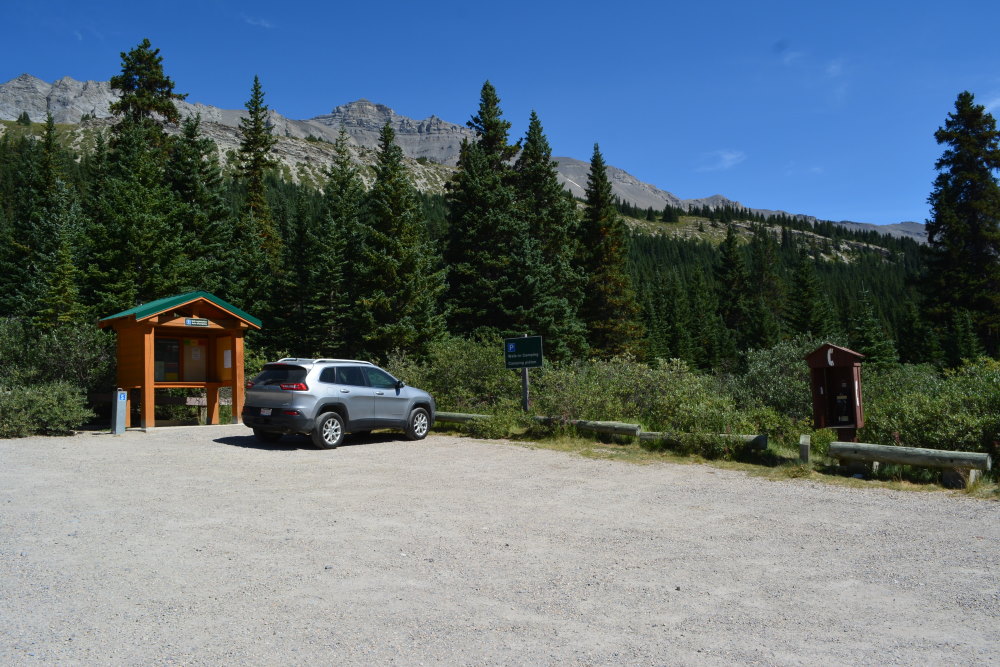
Quality mobile service is a novelty in this part of the park and we were void of it for many dozens of kilometres during our trip to the campground. There seems to be a pocket of reception specifically for the main Columbia Icefields tourist area and immediate surroundings. Continue to travel northward and it soon disappears again until you’re closer to Jasper townsite.
This is great for convenience as well as safety. Also allows for some sweet Instagram posts in real time, if you’re into that sort of thing.
Icefields tent campground is undoubtedly picturesque, but it’s also close to the highway. And Icefields Parkway, during peak travel season, is anything but quiet. Even midweek we could easily hear the fairly regular rumble of vehicle traffic on this world-renowned highway. I can well imagine what its like on weekends … during non-pandemic summers.
In the evening and overnight, though, the traffic subsides considerably. You’ll hear the odd passing car or RV but nothing that’ll keep you up all hours. Nor are there trains like there is along the east-west routes through the parks. When you truly want peace and quiet your biggest disruption will be late arrivals and chatty neighbours.
Columbia Icefields
Of course, you could theoretically come all the way to Icefields Tent campground just to camp there, but odds are you’ve come for the icefields themselves. The Columbia Icefields Discovery Centre, the main tourist structure at the famed Athabasca glacier, is only 1.5km west of the campground. You could literally walk or bike there from your campsite.
We drove because 1) we didn’t have our bikes, 2) we didn’t have our bikes because biking in the mountains would kill me, and 3) we were walking all over creation once we arrived at the various destinations so chose to take it easy getting there and back. Your mileage may vary as will your disdain of what I just wrote.
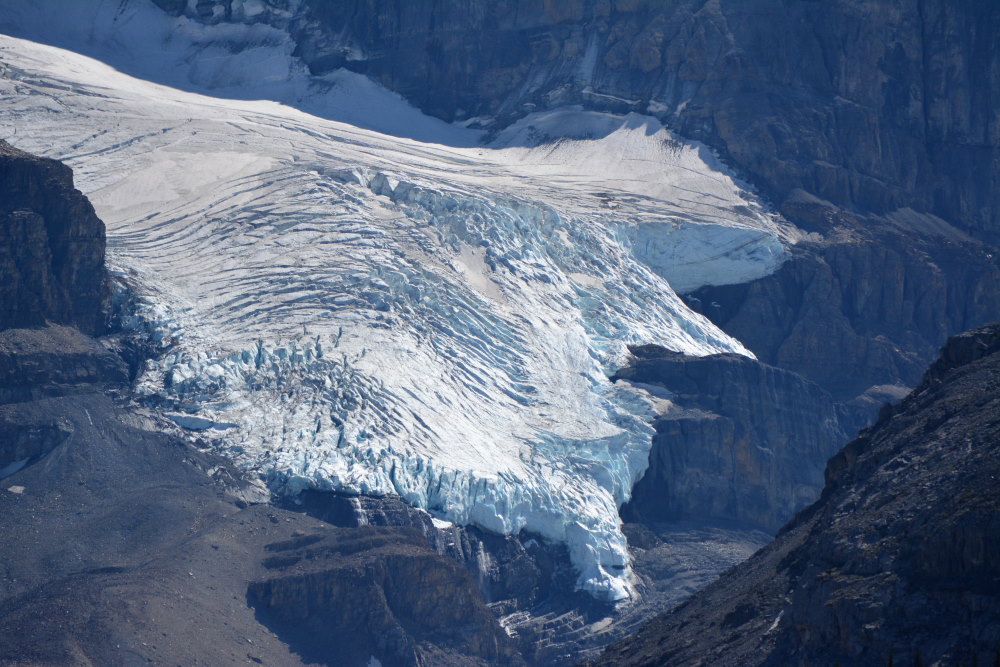
The Columbia Icefields are cool but boy do I wish I could have seen them 30 or 50 or 80 years ago. They are in full retreat in our warming climate and date markers only serve to emphasize the speed of that retreat. I say this without judgment … it would have been awesome to see these glaciers when they were nearly right beside the highway. The way they were when this became a must-see destination in the first place.
As it stands now, and until they disappear completely, the glaciers are a distant attraction. Still pretty, still interesting, but lacking some tangibility. That is unless you pay for a balloon-tired tourist bus ride right onto the glacier.
My son and I chose not to spend the money for this privilege. A package deal for the glacier and the skywalk six kilometers up the road was quite pricy for our tastes. Instead, we took the walking trail up to the foot of the glacier and found that just as rewarding while leaving our spending money for more important things like ice cream.
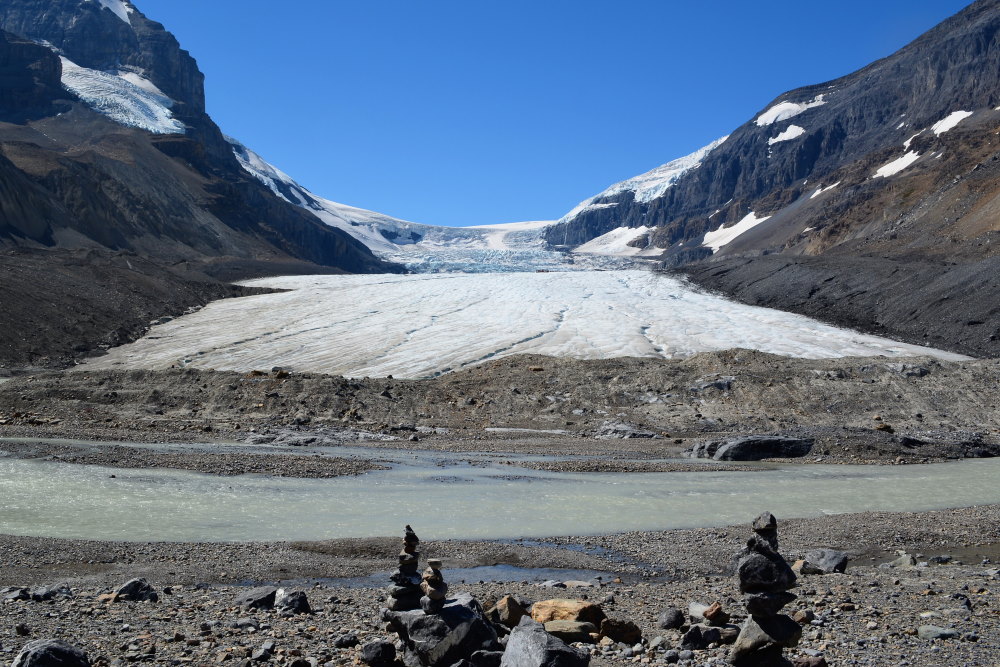
If you’re eager, there is a parking lot near the highway you can park in and walk all the way to the glacier. A second parking lot is found closer to your ultimate destination and that’s where we parked. The trail is rocky and broad, you’re essentially walking on the detritus the glacier left behind, and quite busy as this is a popular spot day in and day out through the summer.
Along this trail is where you’ll find the date markers indicating where the toe of the glacier stood in years past. As you walk through time approaching the glacier it really starts to sink in just how dynamic these sheets of ice really are.
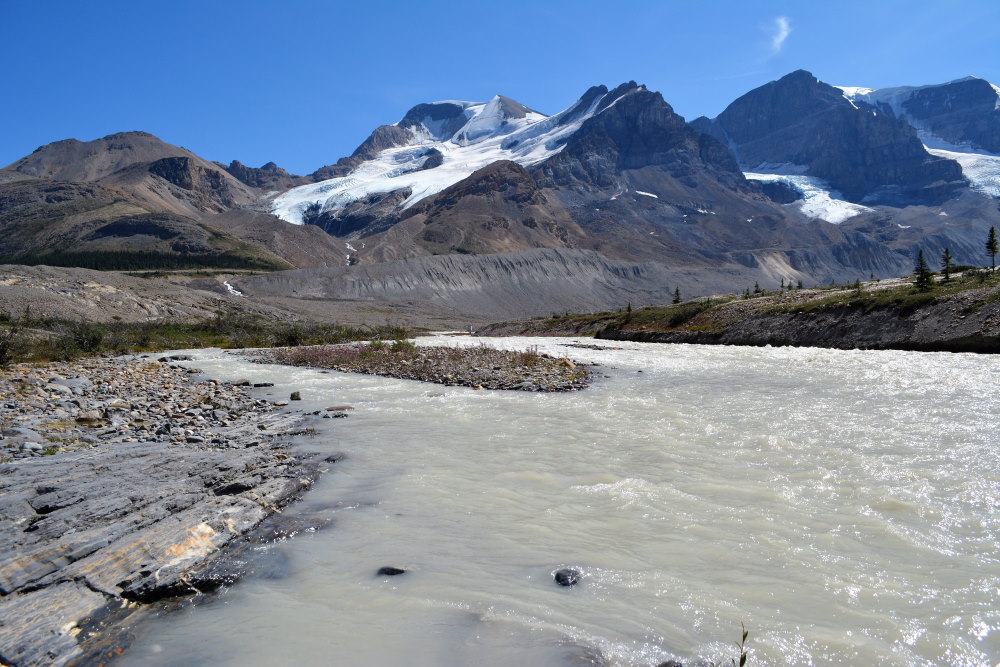
You are unable to walk right up to the glacier. The meltwater flows right across the front of the toe and a few metres back from that is a rope preventing closer approach. As much as you want to touch the glacier, that meltwater is flowing fast and you really don’t want to mess around falling into it.
As the newly born Sunwapta River flows northward from its birthplace, there is a flat, floodplain alongside the highway. There are places to pullover and explore this if you choose. Care is advised when at the river’s edge, those banks aren’t always stable. It’s fun way to rockhound for a bit.

Across the highway, west of the Discovery Center is another valley bottom with some nearby outcrops you can climb. This is also where the terminal moraine of the glacier resides. I wouldn’t call it amazing, by any means, but the geo-curious will enjoy snooping around.
I’ll admit to some regret at not doing the bus tour. On one hand, I recognize that these tours only exacerbate the inevitable melting of the glacier itself. On the other hand, the geologist in me would really have liked to stand on the bloody thing. Ah well, maybe next time. For now, the trail up to, but not quite all the way to, the Athabasca Glacier was fine enough.
Hiking is immensely popular in the area as well and there are many trails around to scratch that itch. They’re plenty longer (and more challenging) than the stroll to the foot of the glacier. I imagine many have significantly better views as well.
We didn’t venture out on any of these trails but if we looked closely at the ridge above the campground, we could see the ant-like movement of hikers on Wilcox Pass Trail. And chatter overheard around Icefields Tent suggests many campers were out hiking during the day.
Our adventures kept us closer to the highway, a not so difficult decision in Jasper considering the plethora of terrific pullouts and hotspots to visit in both directions. Heading towards Jasper, you pass the Jasper Skywalk, one of those glass-bottomed walkways over top of nothing that the scared-of-heights types, like myself, avoid at all costs.
There is no access at the actual skywalk location. You need to pay at the Discovery Centre and are bussed to and from the skywalk. Again, we chose to skip this attraction though the lines indicate many others did not.
Tangle Creek Falls
Further along the highway is Tangle Creek Falls. We stumbled upon this waterfall purely by accident and in doing so screwed it up rather comically.
Approaching from the south, there is a parking lot on the left side of the highway. We pulled in finding it nearly empty at that moment. Looking around we noticed a creek flowing away from the road and promptly scurried off to explore.
Trails spider down the steep hillside. Its immediately obvious these are not official trails but rather the worn tracks of hundreds of curious daredevils. By this point I was questioning the pullout entirely. Why was it even here? There wasn’t much to see from the top and no purposeful trail down into the woods.
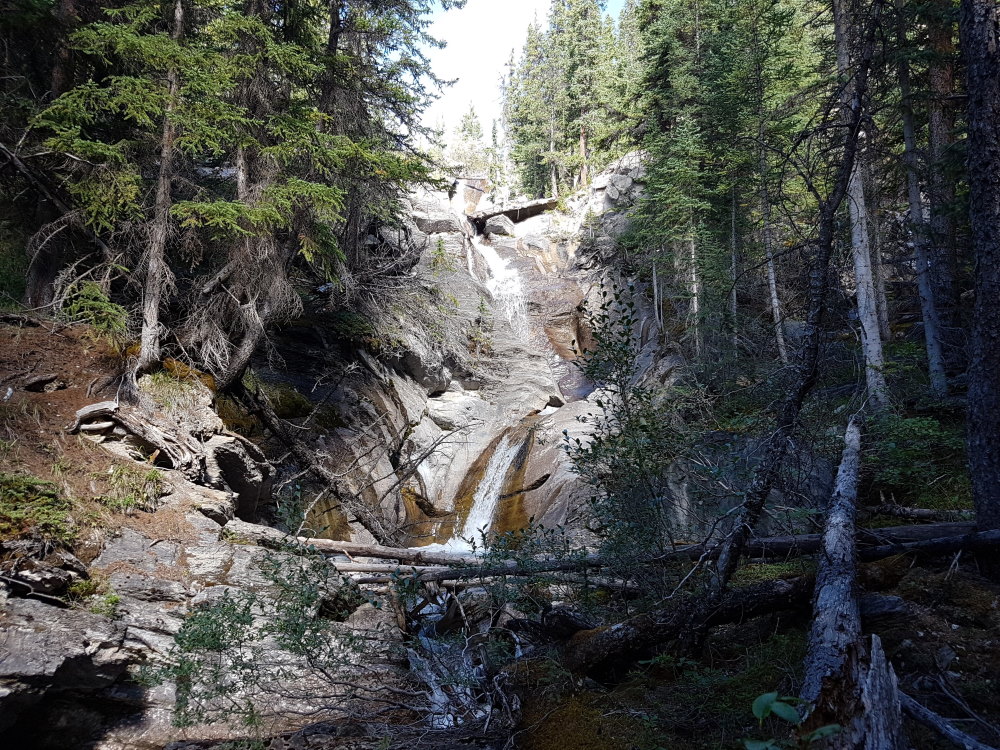
We did discover a waterfall and it was reasonably interesting. We even discovered the former highway and a short concrete slab that must have been a bridge over the creek/waterfall. This was kind of fascinating, if small. One day that slab will completely collapse and drop down to the base of the falls. Hopefully nobody is standing on it when that happens.
After a few minutes of exploration in the thick of the woods around the falls, we returned to the surface where more vehicles had now arrived and parked. We hopped into our car and turned back onto the highway when I was surprised to see several people crossing the road from the parking lot. I glanced to my left and saw the reason for the turnout … there’s a much larger waterfall on the other side of the road!
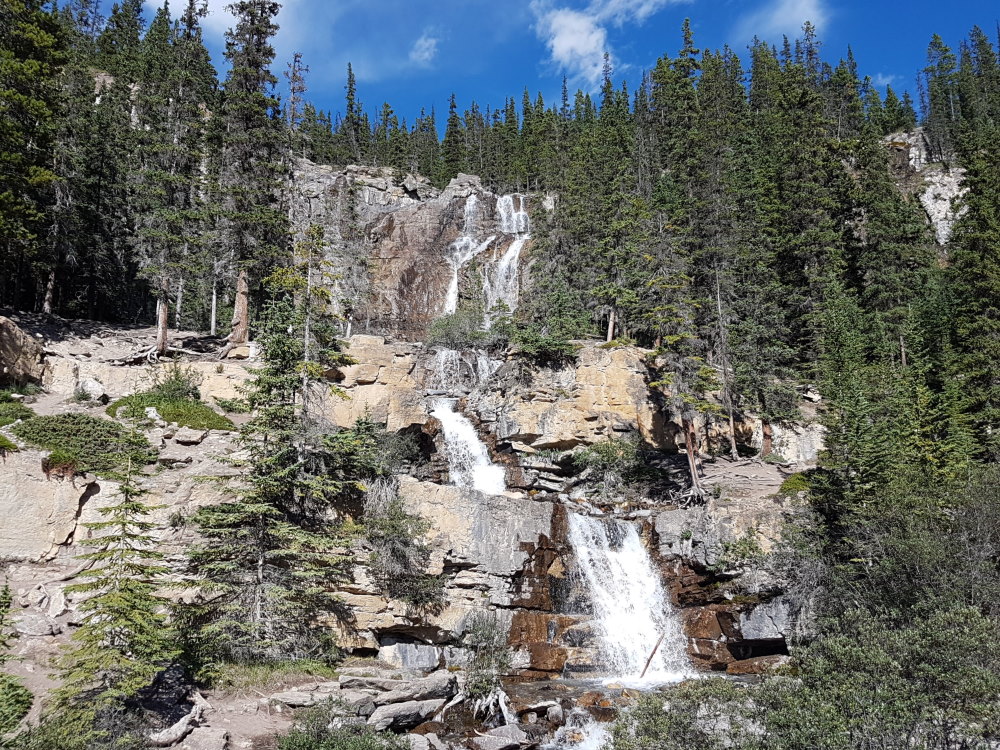
I quickly pulled over and scooted across the road for a picture of Tangle Creek Falls, the very reason for the pullout. It was decidedly cooler than the lower portion we’d spent most of our time investigating and trying to understand. Together the two portions of the waterfall would have made a fantastic attraction. It’s a bloody shame we decided to build a highway through the middle of it … TWICE! Never underestimate the stupidity of humans when it comes to nature, even inside a national park.
There are innumerable viewpoints and natural features to explore in Jasper. We chose not to drive too far from our home base, but those willing will encounter many wonders in this terrific park. You really can’t get enough of the place.
The cherry on top of the Jasper sundae is surely the night sky. At Icefields Tent campground, it was truly amazing. With little light pollution, save for the staff encampment up the highway (grrrr!), a cloudless night sky is remarkably dark. Coupled with the mountain backdrop you’ll witness a sky few of us see anymore.
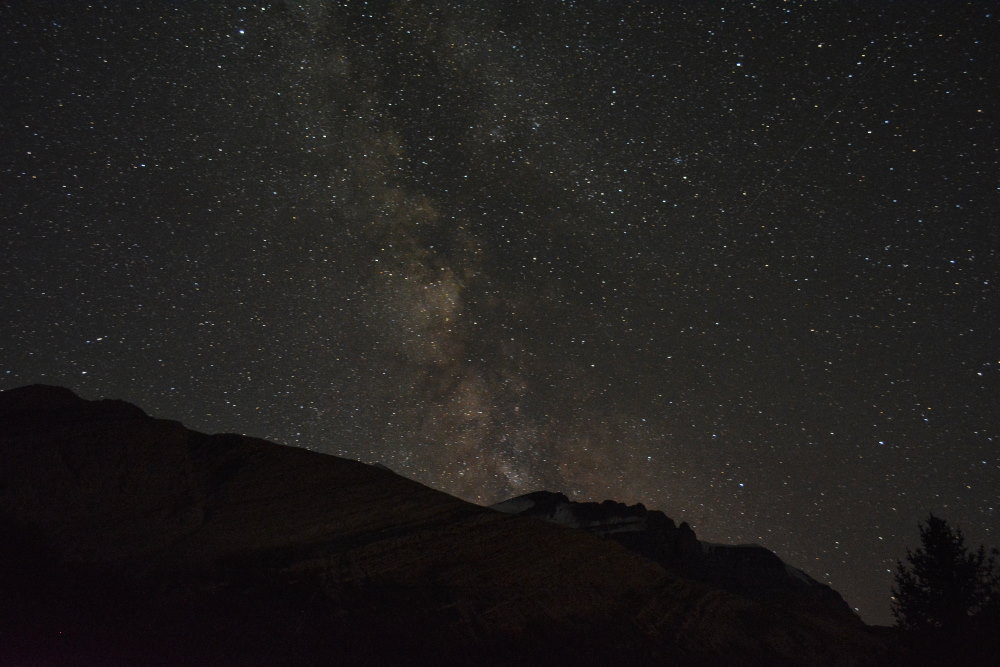
We were fortunate enough to be present for the Perseid meteor shower and it was a delight to witness. Reclining in our chairs just staring upwards, we saw dozens of meteors zoom across the sky. The Milky Way and the constellations painted a beautiful picture between each cosmic slash of light.
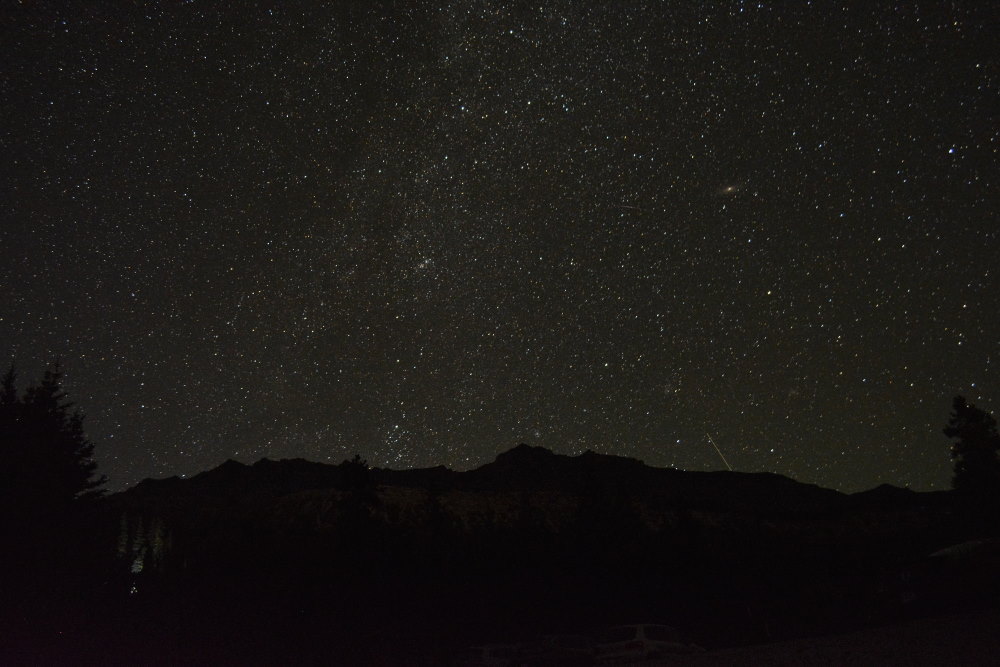
When all was said and done, we left elated but exhausted. Two late nights after days of sightseeing will do that. Totally worth it, though.
Giving Icefields Tent campground a rating is difficult. I obviously had a great time and liked the place plenty well. The non-odorous pit toilets are a welcome anomaly. The apparent lack of wood supply, a disappointment. The campground is overall appealing but, and this may sound weird, the trees blocking the mountain views from so many sites was kind of a downer. I know … sacrilege.
As my first experience in a tent only campground, I have few complaints. I have zero doubts this place gets a bit rowdy during peak summer travel, on weekends, in non-pandemic circumstances but I’m finding myself not wanting it to be any other way. That too is a rarity coming from my ancient lips. It just seems like the type of place a younger, outdoorsy crowd should enjoy.
So, I’ll give Icefields Tent campground in Jasper National Park 4.25 Baby Dill Pickles out of 5. The powerful afterglow of successful father-son bonding will do that, I guess.
Find another campground here.

